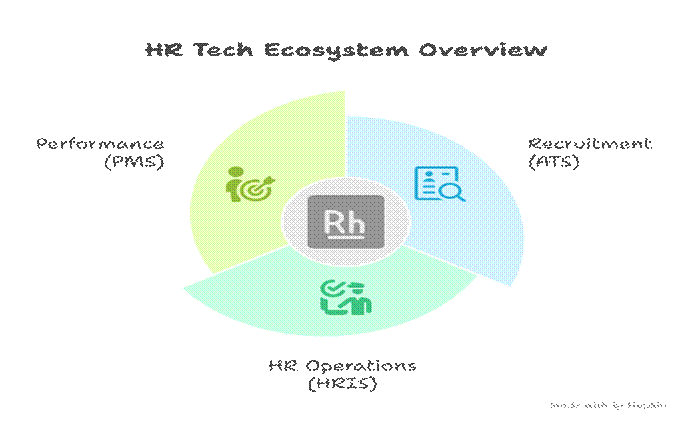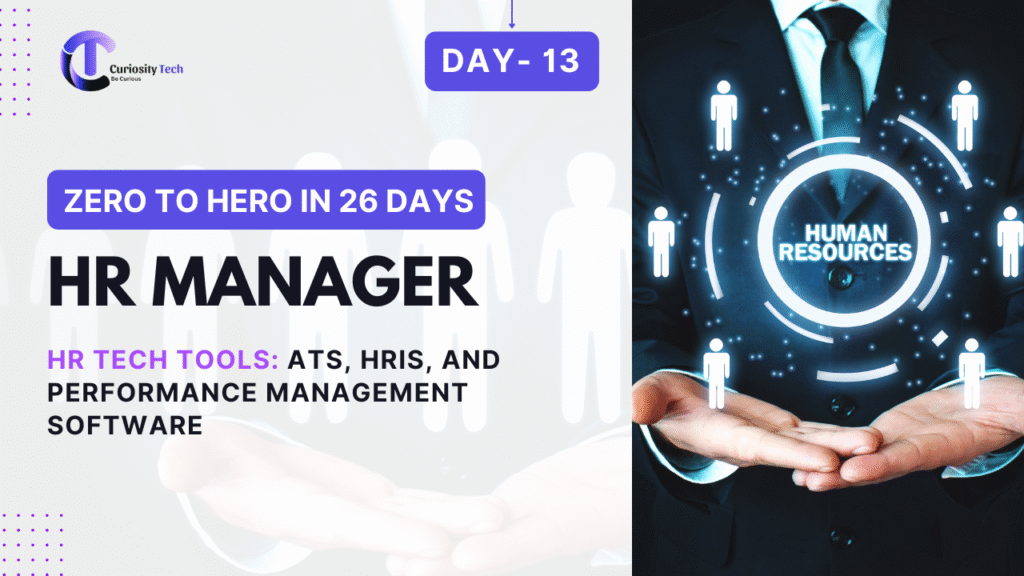Introduction: Why HR Tech Is the New Backbone of HR
In 2025, no HR department can operate effectively without technology. Recruitment, employee data, payroll, performance tracking, and compliance all depend on HR Tech tools.
At Curiosity Tech (Nagpur, curiositytech.in), leaders realized early that spreadsheets and manual processes cannot keep pace with growing teams. They invested in ATS (Applicant Tracking System), HRIS (Human Resource Information System), and Performance Management Software (PMS) to streamline operations and strengthen decision-making.
This blog will act as a buyer’s guide for HR managers, comparing these three core categories of HR software, and showing how to adopt them strategically.
Section 1: The Three Pillars of HR Tech
| Tool | Primary Purpose | Who Uses It | Example at Curiosity Tech |
| ATS (Applicant Tracking System) | Recruitment & hiring | Recruiters, HR, hiring managers | Used to filter 500+ resumes per job posting |
| HRIS (Human Resource Information System) | Centralized HR data & processes | HR, Finance, Admin | Stores all employee records digitally |
| Performance Management Software | Monitoring, evaluating, and rewarding performance | Managers, HR, leadership | Tracks OKRs and links bonuses to results |
Section 2: Comparative Analysis – ATS vs HRIS vs PMS
Applicant Tracking System (ATS)
- What it does:
- Job posting automation.
Resume parsing with AI.
- Candidate pipeline management.
- Job posting automation.
- Pros: Faster hiring, better candidate experience.
- Cons: Can be costly for startups.
Example at Curiosity Tech:
The HR team integrated an ATS that automatically filters resumes based on skills. In one case, 1,200 resumes were reduced to 85 shortlisted candidates in under 24 hours.
Human Resource Information System (HRIS)
- What it does:
- Digital employee database.
Attendance & leave tracking.
Payroll integration.
- Digital employee database.
- Cons: Data migration from legacy systems can be time-consuming.
Example at Curiosity Tech:
The HRIS serves as a single source of truth, linking payroll, attendance, training, and employee self-service portals. Employees can log in at curiositytech.in to view payslips, apply for leave, and update their details.
Performance Management Software (PMS)
- What it does:
- Sets goals and OKRs.
Tracks employee progress.
Automates performance reviews.
- Sets goals and OKRs.
- Pros: Transparent, data-driven appraisals.
- Cons: Requires cultural adaptation — some managers resist “being measured.”
Example at Curiosity Tech:
A PMS was introduced to replace subjective appraisals with data-based reviews. Engagement scores improved by 27% within a year, as employees felt reviews were fairer and more transparent.
Section 3: Hierarchical Diagram – HR Tech Ecosystem

This ecosystem approach ensures all tools work together — exactly how Curiosity Tech integrated its HR systems.
Section 4: Use-Case Matrix
| Business Size | ATS Need | HRIS Need | PMS Need |
| Startup (0–50 employees) | Low | Medium | Low |
| Mid-Size (50–500) | High | High | Medium |
| Large Enterprise (500+) | Very High | Very High | Very High |
Curiosity Tech Case:
When Curiosity Tech grew past 100 employees, an ATS and HRIS became non-negotiable. As they expanded to multiple offices, PMS was added for transparency in promotions.
Section 5: Key Features to Look for in Each Tool
| Category | Must-Have Features |
| ATS | Resume parsing, candidate tracking, multi-channel job posting |
| HRIS | Payroll integration, compliance reports, employee self-service |
| PMS | OKR alignment, continuous feedback, 360-degree reviews |
Section 6: Cost Considerations
- ATS: ₹40,000–₹1.5 lakh annually (depends on recruitment volume).
- HRIS: ₹60,000–₹3 lakh annually (depends on modules).
- PMS: ₹50,000–₹2 lakh annually (depends on employee count).
ROI Insight (Curiosity Tech):
Automation of payroll and recruitment saved ~600 HR hours annually, equating to a cost saving of nearly ₹12 lakh.
Section 7: Challenges in HR Tech Adoption
- Data Migration Issues – Old files don’t always integrate.
- Resistance from Employees – Some fear “surveillance.”
- Training Gaps – Managers need digital literacy.
- Vendor Lock-In – Choosing the wrong system can be costly.
Curiosity Tech tackled these challenges through phased implementation and HR digital bootcamps for managers.
Section 8: Future of HR Tech (2025–2030)
- AI in Recruitment: Predicts candidate cultural fit.
- Blockchain HRIS: Secure employee records.
- Gamified PMS: Employees earn “growth points.”
- Voice-Driven HR Portals: Employees ask Alexa-style systems for leave or payslips.
At Curiosity Tech, pilots are already underway for AI-driven HR chatbots that answer FAQs like “What’s my leave balance?” instantly.
Case Study Snapshot – Curiosity Tech’s HR Tech Journey
- Before: Paper files, Excel-based tracking, slow hiring.
- After:
- ATS reduced hiring cycle by 45%.
HRIS digitized all employee data.
- PMS boosted employee trust in appraisals.
- ATS reduced hiring cycle by 45%.
- Impact: Overall HR efficiency increased by 32%, employee satisfaction improved by 21%.
Conclusion
HR Tech is no longer optional. ATS, HRIS, and PMS form the core triad of modern HR systems. While small companies can start small, scaling organizations like Curiosity Tech in Nagpur demonstrate the importance of integrating these tools for speed, transparency, and accuracy.
For HR managers, adopting these systems is not just about efficiency — it’s about building an employee experience that is seamless, fair, and future-ready.
Description
A comprehensive buyer’s guide to HR Tech tools. Covers ATS, HRIS, and Performance Management Software, with comparative analysis, features, costs, Curiosity Tech case examples, and future trends in HR digital transformation.

